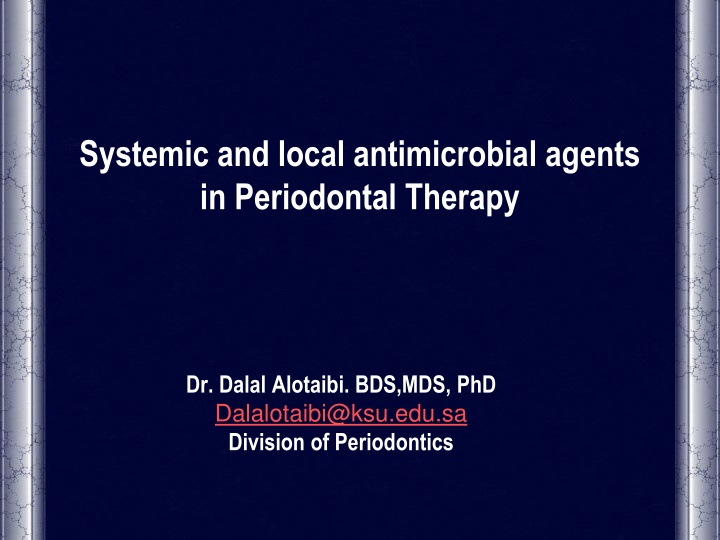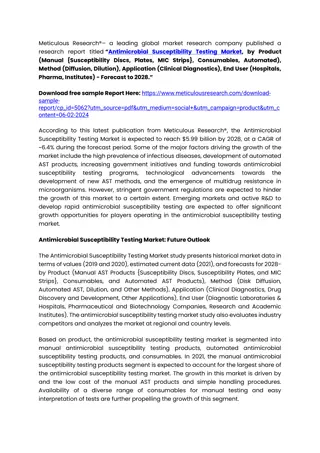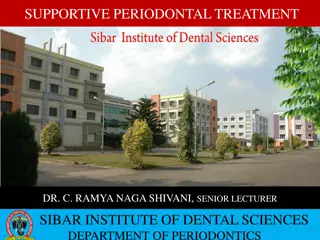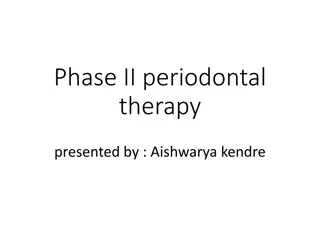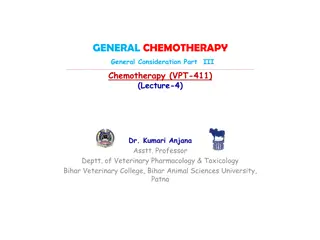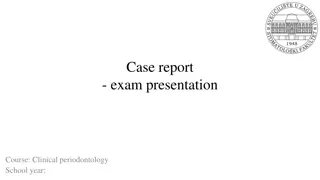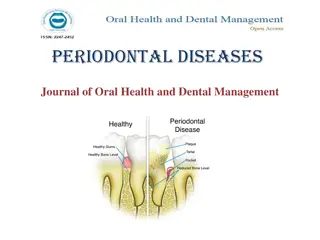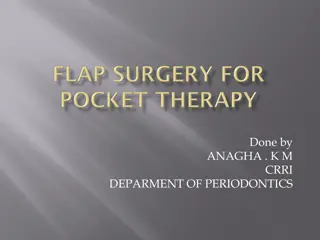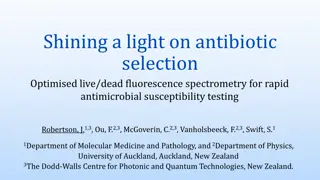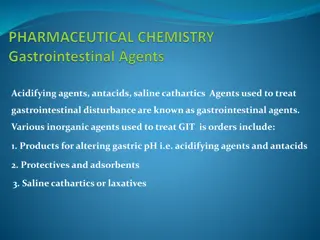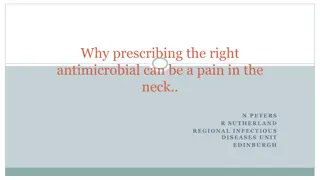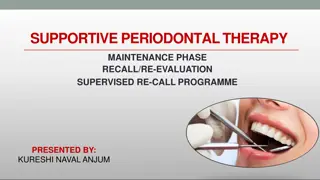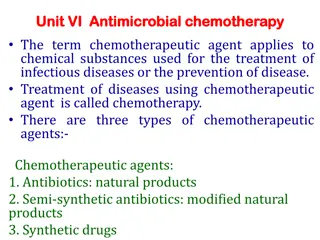Antimicrobial Agents in Periodontal Therapy
In this material by Dr. Dalal Alotaibi, the systemic and local administration of antimicrobial agents in periodontal therapy is outlined. It covers the rationale, advantages, dosage, and types of controlled release systems used, along with definitions of antiinfective agents, antibiotics, and antiseptics. It discusses bactericidal and bacteriostatic actions, narrow-spectrum vs. broad-spectrum antibiotics, and ideal requisites of antibiotics.
Download Presentation

Please find below an Image/Link to download the presentation.
The content on the website is provided AS IS for your information and personal use only. It may not be sold, licensed, or shared on other websites without obtaining consent from the author.If you encounter any issues during the download, it is possible that the publisher has removed the file from their server.
You are allowed to download the files provided on this website for personal or commercial use, subject to the condition that they are used lawfully. All files are the property of their respective owners.
The content on the website is provided AS IS for your information and personal use only. It may not be sold, licensed, or shared on other websites without obtaining consent from the author.
E N D
Presentation Transcript
Systemic and local antimicrobial agents in Periodontal Therapy Dr. Dalal Alotaibi. BDS,MDS, PhD Dalalotaibi@ksu.edu.sa Division of Periodontics
Comprehend the systemic administration of antibiotics in periodontal diseases Judge when to apply single or combination of antibiotic therapy Apply local delivery of antibiotics Apply local delivery of antiseptic agent. REFERENCE: CARRANZA s Clinical Periodontology 11th Edition. Antiinfective therapy.Chapter 47 pg 482
Outline Discuss the rationale for the use of antimicrobial agents in the treatment of periodontal diseases Advantages of the specific antibiotics Dosage used in treating periodontal disease Types of controlled release systems (local antibiotic)
Definitions An antiinfective agent is a chemotherapeutic agent that acts by reducing the number of bacteria present. An antibiotic is a naturally occurring, semisynthetic, or synthetic type of antiinfective agent that destroys or inhibits the growth of selective microorganisms, generally at low concentrations. An antiseptic is a chemical antimicrobial agent applied topically or subgingivally to mucous membranes, wounds, or intact dermal surfaces to destroy microorganisms. Disinfectants, a subcategory of antiseptics, are antimicrobial agents that are generally applied to inanimate surfaces to destroy microorganisms
Bactericidal: kill bacteria by interfering with bacterial cell wall (penicillins and cephalosporins) or the cell membrane (polymyxins) Bacteriostatic: target protein or DNAsynthesis Spirochetes and motile rods Anaerobic bacteria: is any organism that does not require oxygen for growth
"Narrow-spectrum" antibacterial antibiotics target specific types of bacteria, such as Gram- negative or Gram-positive bacteria broad-spectrum antibiotics affect a wide range of bacteria
Ideal requisites of an antibiotic 1. Bacterial specificity 2. Should not produce resistant strains 3. Does not cause allergy or toxicity 4. Does not cause side effects 5. Does not eliminate normal oral flora 6. Cost effective
Mechanism of action Antibiotics Categories Bactericidal Bacteriostatic Interfere with Cell Membrane Interfere with Protein Synthesis Interfere with Nucleic Synthesis Inhibition Cell Wall Synthesis
Antiinfective therapy in Periodontics Host's own immunologic response to this bacterial infection can cause even more bone destruction ( indirect bone loss ) than that caused by pathogenic bacteria and their by-products. Mainly influenced by environmental (e.g., tobacco use), acquired (e.g., systemic disease), and genetic risk factors. Chemotherapeutic agents can modulate the host's immune response to bacteria and reduce the host's self-destructive immunologic response.
Antibiotics in Periodontics Specific for periodontal pathogens, allogenic, nontoxic, and inexpensive. No single antibiotic at concentrations achieved in body fluids inhibits all putative periodontal pathogens. A combination of antibiotics may be necessary to eliminate all putative pathogens from some periodontal pockets
Commonly prescribed Antibiotics in Periodontal therapy Tetracycline's Minocycline, Doxycycline Metronidazole Amoxicillin, Augmentin Ciprofloxacin Clindamycin Doxycycline Azithromycin
Tetracycline Clinical Use: Refractory periodontitis Localized aggressive periodontitis Use in combination therapies more effective
Tetracycline Mechanism of action: Bacteriostatic, broad spectrum More effective against gram + positive bacteria Concentration in the gingival crevice is 2 to 10 times that in serum allowing a high drug concentration to be delivered into periodontal pockets Inhibit the growth of Aggregatibacter actinomycetemcomitans Inhibits production & secretion of collagenase Inhibits bone resorption Dosage 250 mg capsules 4 times a day (qid)
Tetracycline Side Effects Intrinsic tooth staining GI upset, abdominal pain Diarrhea, vomiting Fungal overgrowth Resistant bacterial strains Interferes with bactericidal activity of penicillin's & Cephalosporin
Minocycline Broad-spectrum tetracycline antibiotic It is a bacteriostatic antibiotic It suppresses spirochetes and motile rods as effectively as scaling and root planing, up to 3 months after therapy Dose : 200 mg twice daily (bid) Adverse Effect: It may cause reversible vertigo It is the only tetracycline that can discolor permanently erupted teeth and gingival tissue when administered orally.
Doxycycline Broad-spectrum tetracycline antibiotic Same spectrum of activity as minocycline It can be given once daily Absorption from the GIT is not altered by calcium, metal ions, or antacids Dosage: 100 mg daily
Metronidazole Mechanism of action: Bactericidal/Bacteriostatic antimicrobial used particularly for anaerobic bacteria Disrupts DNA synthesis leading to cell death Selectively kills bacterial associated with periodontal disease Used as monotherapy and also in combination with both root planing and surgery or with other antibiotics Dosage: 250 mg tid for 7-10 days
Metronidazole Clinical use: Refractory periodontitis (in combination with amoxicillin/ augmentin) Necrotizing ulcerative gingivitis Moderate severe periodontitis Aggressive periodontitis Following periodontal surgery
Metronidazole Side Effects GI disturbances, Nausea, diarrhea Head ache Metallic taste, Dry mouth Candida infections Adverse interaction with alcohol consumption
Clindamycin & Ciprofloxacin Clindamycin Clindamycin is effective against anaerobic bacteria and has a strong affinity for osseous tissue. It is effective in situations in which the patient is allergic to penicillin Dosage : 150 mg qid for 10 days. Ciprofloxacin Ciprofloxacin is active against gram-negative rods and anaerobic putative periodontal pathogens. Ciprofloxacin is the only antibiotic in which all strains of A. actinomycetemcomitans are susceptible. Dosage : 500mg bid for 8 days
Amoxicillin Is a semi synthetic penicillin Broad spectrum gram positive and negative bacteria. Excellent absorption after oral administration. Management of patients with aggressive periodontitis Dosage : 500 mg tid
Amoxicillin - Clavulanate (Augmentin) The combination of amoxicillin with Clavulanate potassium makes Augmentin resistant to penicillinase enzymes produced by some bacteria. Useful in the management of patients with refractory or localized aggressive periodontitis Dosage: 375-625mg tid for 7 days
Azithromycin Azithromycin is a macrolide antibiotic effective against the most common periodontopathogens. Azithromycin have a triple role in the treatment and resolution of periodontal diseases: -suppressing periodontopathogens, -anti-inflammatory activity -healing through persistence at low levels in macrophages and fibroblasts in periodontal tissues, even after a single course of three tablets Dosage: 500mg once daily
Common Antibiotic Regimens Used to Treat Periodontal Diseases Single Agent Amoxicillin 500 mg Three times daily for 8 days Azithromycin 500 mg Once daily for 3 7 days Ciprofloxacin 500 mg Twice daily for 8 days Clindamycin 300 mg Three times daily 10 days Doxycycline 100 200 mg Once daily for 21 days Metronidazole 500 mg Three times daily for 8 days Combination Therapy* Amoxicillin-metronidazole (250 mg amoxicillin-375 mg metronidazole, 3 times daily for 8 days) is the most common antibiotic combination in periodontics. Ciprofloxacin-metronidazole (500 mg of each, twice daily for 8 days)
Controlled Release Agents (local delivery systems) Suppressing destructive enzymes produced during inflammatory process or by suppressing microbes Considered mainly for localized periodontitis
Advantages of local drug delivery Concentration achievable locally is higher Better patient compliance GCF concentration greater than serum levels Delivery is localized reduces systemic effects No systemic drug resistance
Currently available Systems Actisite (tetracycline fiber) Atridox (doxycycline gel) Arestin (minocycline HCl 1mg) Dentamycin (2% minocycline hydrochloride) PerioCline (2% minocycline hydrochloride) Elyzol (25 % Metronidazole gel) Periochip (2.5 mg of Chlorhexidine gluconate)
ActisitePeriodontal Fiber (Tetracycline) Ethylene / vinyl acetate copolymer fiber, diameter 0.5 mm, containing tetracycline (12.7 mg) releases tetracycline concentrations exceeding 1300 g/ml Fiber inserted into the pocket Removed after 7 to 10 days after placement
Actisite Clinical Efficacy: Reduction in bleeding on probing and pocket depth Reduction in periodontal pathogens Adverse effects: Discomfort Local erythema Occasional systemic reaction Oral Candidiasis
Minocycline - Arestin Clinical indication: Periodontitis with pockets more than 5 mm Mechanism of action: Broad spectrum Bacteriostatic GCF levels maintained at high levels for at least 14 days
Atridox (Doxycycline) 10% Doxycycline hyclate Biodegradable syringe system
Metronidazole Gel (Elyzol) It is a bio-absorbable delivery device containing 25% Metronidazole benzoate in a matrix consisting of a mixture of glyceryl monooleate and sesame oil.
PerioChip Description: Rectangular chip, supplied in boxes of 10 Contains 2.5 mg Chlorhexidine D-gluconate Biodegradable matrix of hydrolyzed gelatin
PerioChip Mechanism of action: Bactericidal antiseptic agent Binds with tissue no need for surgical dressing Chip gradually biodegrades releasing CHX Sustained release over period of 7-10 days GCF concentrations vary among clients Peaks at (2- 4) hours after insertion Peaks again at approx. 72 hours Concentrations gradually decline over 7-10day period
Summary Antimicrobial agents The decision as to when to use local or systemic antimicrobials should be based on the clinicians consideration of the clinical findings patient's medical and dental history patient preferences benefits of adjunctive therapy with these agents.
